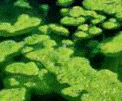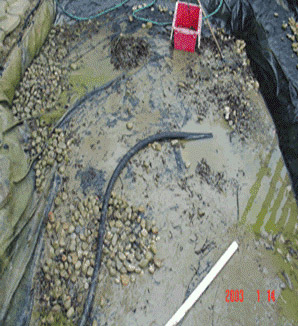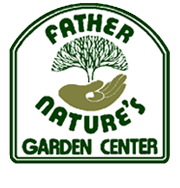 Algae Problems in Water Gardens Algae problems in water gardens are generally Algae_11caused by the action of the sun and excess nutrients (bad bacteria) in the water. If ponds are established properly and balanced with the correct ratio of plants, fish, algae control and algae problems are not difficult to control.
Algae Problems in Water Gardens Algae problems in water gardens are generally Algae_11caused by the action of the sun and excess nutrients (bad bacteria) in the water. If ponds are established properly and balanced with the correct ratio of plants, fish, algae control and algae problems are not difficult to control.
Using the proper filter system and adding good bacteria will greatly reduce algae from your pond. If you do not use proper filtration and add good bacteria, green water conditions will exist for about 3-4 weeks but will clear as the water equalizes. The general cause of algae in ponds is excess nutrients from either the overstocking or overfeeding of fish, over fertilization of plants, too few plants in the pond. A general rule for stocking fishponds is to use 4-6 goldfish and one water lily for every square yard of water surface. Feed fish a specified amount of food per day, and only if necessary. Most fish can survive on naturally occurring foods within a balanced system. General methods for reducing algae in ponds include the reduction of nutrients causing the algae by (adding anacharis plants to your pond). To reduce nutrients, reduce the feeding of the fish, the level of fish stocked in the pond or the fertilization of the plants.
Other methods to reduce algae problems are flushing the pond and adding new water; adding additional aquatic plants to allow as much as 50 percent of the water surface to be covered; and adding a biological filter system in larger ponds.The use of algae reducing chemicals should be the last resort in small ponds. Injury to both plant and animal life in the pond can easily result with misapplication. Copper compounds are the most often used but must be used in strict accordance with label directions. It is often better to look at the cause of imbalance and correct it before resorting to chemicals.
 Spring Cleaning As the days get longer and the sun warms the air we begin to see activity in our ponds. The fish become more active. To properly clean apond you should empty the pond and power wash the inside to remove built up debris and leaves that may have blown in during the winter. The removal of this debris will remove potential sources of ammonia, nitrites and nitrates from your water, which is also toxic to fish. While in the pond you should see new growth on plants. Little leaves will be forming hardy water lilies and water irises for the sun trim or pinch the old growth and all yellowing leaves off yourplants. Divide and repot plants if needed. You can fertilize your plants at this time with fish-safe fertilizer pellets to help give the plants a jump-start on the season. Place your plants at their appropriate depths or set in shallow water to encourage quicker growth and then placing them at the depth you want them to be. Refill the pond and add water neutralizer so fish can be put back relatively quickly. Return your pump to the water after careful inspection of it (some people leave their pumps running all winter). If you have biological filters beneficial bacteria should be added at this time. The fish will be coming up to the surface looking for food. You should not feed your fish food until the water temperature reaches 50 degrees F. Wheat-germ-based floating pellets are a good source of food for your fish at this time. Feed them in the morning so that they have ample time to digest their food before the night turns cool. Keep a watch for parasites and disease in your fish.
Spring Cleaning As the days get longer and the sun warms the air we begin to see activity in our ponds. The fish become more active. To properly clean apond you should empty the pond and power wash the inside to remove built up debris and leaves that may have blown in during the winter. The removal of this debris will remove potential sources of ammonia, nitrites and nitrates from your water, which is also toxic to fish. While in the pond you should see new growth on plants. Little leaves will be forming hardy water lilies and water irises for the sun trim or pinch the old growth and all yellowing leaves off yourplants. Divide and repot plants if needed. You can fertilize your plants at this time with fish-safe fertilizer pellets to help give the plants a jump-start on the season. Place your plants at their appropriate depths or set in shallow water to encourage quicker growth and then placing them at the depth you want them to be. Refill the pond and add water neutralizer so fish can be put back relatively quickly. Return your pump to the water after careful inspection of it (some people leave their pumps running all winter). If you have biological filters beneficial bacteria should be added at this time. The fish will be coming up to the surface looking for food. You should not feed your fish food until the water temperature reaches 50 degrees F. Wheat-germ-based floating pellets are a good source of food for your fish at this time. Feed them in the morning so that they have ample time to digest their food before the night turns cool. Keep a watch for parasites and disease in your fish.
Spring Cleaning As the days get longer and the sun warms the air we begin to see activity in our ponds. The fish become more active. To properly clean apond you should empty the pond and power wash the inside to remove built up debris and leaves that may have blown in during the winter. The removal of this debris will remove potential sources of ammonia, nitrites and nitrates from your water, which is also toxic to fish. While in the pond you should see new growth on plants. Little leaves will be forming hardy water lilies and water irises for the sun trim or pinch the old growth and all yellowing leaves off yourplants. Divide and repot plants if needed. You can fertilize your plants at this time with fish-safe fertilizer pellets to help give the plants a jump-start on the season. Place your plants at their appropriate depths or set in shallow water to encourage quicker growth and then placing them at the depth you want them to be. Refill the pond and add water neutralizer so fish can be put back relatively quickly. Return your pump to the water after careful inspection of it (some people leave their pumps running all winter). If you have biological filters beneficial bacteria should be added at this time. The fish will be coming up to the surface looking for food. You should not feed your fish food until the water temperature reaches 50 degrees F. Wheat-germ-based floating pellets are a good source of food for your fish at this time. Feed them in the morning so that they have ample time to digest their food before the night turns cool. Keep a watch for parasites and disease in your fish.

